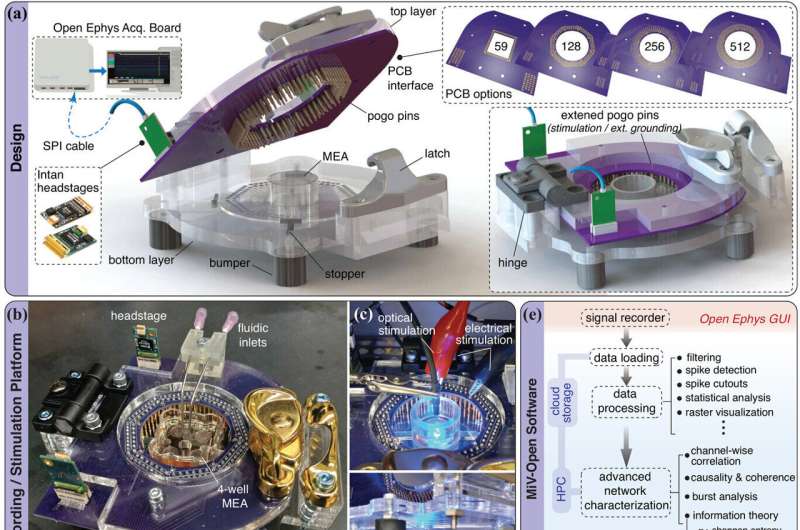
Neurons intricately talk and reply to stimuli inside an unlimited community, orchestrating important features from fundamental bodily processes to complicated ideas. Conventional neuroscience strategies, counting on in vivo electrophysiology (inside a dwelling organism), usually have issue addressing the complexity of the mind as an entire.
Another method includes extracting cells from the organism and conducting research on a tradition dish as an alternative (in vitro), offering researchers with enhanced management and precision in measuring neural processes.
In a brand new research featured in Superior Science, researchers unveil a cheap, open-source in vitro system for interfacing with neurons, providing a extra accessible avenue for researchers concerned about neural interactions.
The research is an element of a bigger mission known as Thoughts in Vitro, which explores how neurons work together with one another, not solely to higher perceive the features underlying complicated methods just like the mind, but in addition for the objective of ultimately utilizing in vitro neural networks for computation. To perform such a objective, the MiV mission encompasses a extremely interdisciplinary group of researchers, together with these from pc science, engineering, neurobiology, physiology, and extra.
“The objective of the MiV mission is to in the end use neurons for computation,” defined Zhi (Andrew) Dou, a graduate pupil within the Gazzola lab who helped lead the mission. “This might enable for a system that’s dynamic and always evolving, not like conventional computing methods, and is definitely extra power environment friendly as properly.”
The brand new MiV research, led by Mattia Gazzola (M-CELS), an affiliate professor of mechanical science and engineering, Xiaotian Zhang, a postdoctoral researcher in Gazzola’s lab, and Dou, describes an progressive method to measuring neuron exercise utilizing micro-electrode array (MEA) know-how. Whereas there are business methods that make the most of related know-how, they’re usually costly and marketed towards particular experimental approaches.
“The issue with the present know-how for interfacing with neurons is that it is primarily business methods, that are extra standardized for particular testing circumstances, usually inside biochemistry or conventional neuroscience,” mentioned Zhang. “Since we’re concerned about engineering computing paradigms out of dwelling cells, our motivation for this was to maneuver away from the extra standardized business methods and construct one thing ourselves that we might have full management over.”
Within the new MiV equipment, cells are positioned onto a plate that comprises MEAs, permitting the know-how to interface with the neural substrates. The electrodes detect voltage from the neurons, and that voltage is amplified and despatched to a pc, which then processes the information.
In comparison with the usual 60-electrode business system, the MiV system boasts over 500 electrodes, which permits for extra knowledge to be collected without delay. The system additionally incorporates improved and/or novel options in comparison with business methods, akin to portability, bi-directional communication with neurons, the flexibility to picture neurons throughout recordings, and the flexibility to check a number of kinds of enter (electrical and optical) and a number of cell populations at a time.
Regardless of these enhancements, the price to construct the MiV system is shockingly 10-times cheaper than the price of a business system, and fully customizable. As a way to additional the dissemination of the system, the researchers have made their {hardware} and software program fashions for the MiV system open supply and freely accessible on-line.
“Having our software program and {hardware} be open supply was actually vital to us,” mentioned Zhang. “We needed to convey the price right down to make this know-how accessible to others, and have or not it’s extra versatile and versatile in order that researchers can actually customise their experimental settings for no matter they want. Our system isn’t for just one lab, or one group of individuals concerned about one particular factor, it is for everybody.”
“We designed our system to be very simple to make and comprised of cheap components, which is able to enable numerous labs that may’t afford the business system to have their very own system,” mentioned Dou. “Although the unique design is for computational research, we have made the construction simple to revamp and develop upon, so we’re fairly certain this may fulfill researchers irrespective of the form of research they need to do.”
The researchers say different labs are already exhibiting curiosity within the new know-how for their very own experiments. The MiV staff plans to maintain bettering the design to make the {hardware} extra automated and accessible, in addition to discover methods to quantify and develop the know-how’s efficiency.
Hyperlinks for the open-source {hardware} designs and software program might be discovered at and respectively.
Extra info:
Xiaotian Zhang et al, Thoughts In Vitro Platforms: Versatile, Scalable, Sturdy, and Open Options to Interfacing with Residing Neurons, Superior Science (2024). DOI: 10.1002/advs.202306826
College of Illinois at Urbana-Champaign
Quotation:
Researchers design new open-source know-how for interfacing with dwelling neurons (2024, January 23)
retrieved 23 January 2024
from
This doc is topic to copyright. Other than any truthful dealing for the aim of personal research or analysis, no
half could also be reproduced with out the written permission. The content material is supplied for info functions solely.







